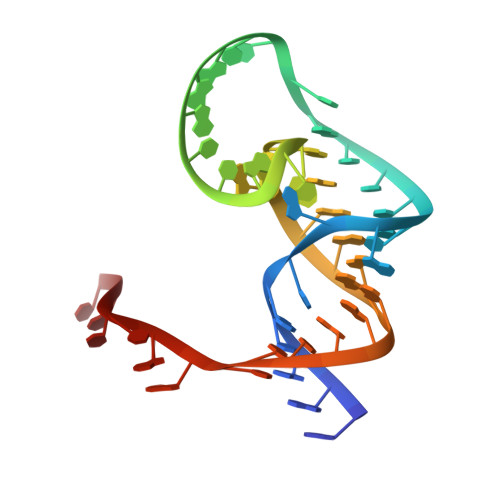A folded viral noncoding RNA blocks host cell exoribonucleases through a conformationally dynamic RNA structure.
Steckelberg, A.L., Akiyama, B.M., Costantino, D.A., Sit, T.L., Nix, J.C., Kieft, J.S.(2018) Proc Natl Acad Sci U S A 115: 6404-6409
- PubMed: 29866852
- DOI: https://doi.org/10.1073/pnas.1802429115
- Primary Citation of Related Structures:
6D3P - PubMed Abstract:
Folded RNA elements that block processive 5' → 3' cellular exoribonucleases (xrRNAs) to produce biologically active viral noncoding RNAs have been discovered in flaviviruses, potentially revealing a new mode of RNA maturation. However, whether this RNA structure-dependent mechanism exists elsewhere and, if so, whether a singular RNA fold is required, have been unclear. Here we demonstrate the existence of authentic RNA structure-dependent xrRNAs in dianthoviruses, plant-infecting viruses unrelated to animal-infecting flaviviruses. These xrRNAs have no sequence similarity to known xrRNAs; thus, we used a combination of biochemistry and virology to characterize their sequence requirements and mechanism of stopping exoribonucleases. By solving the structure of a dianthovirus xrRNA by X-ray crystallography, we reveal a complex fold that is very different from that of the flavivirus xrRNAs. However, both versions of xrRNAs contain a unique topological feature, a pseudoknot that creates a protective ring around the 5' end of the RNA structure; this may be a defining structural feature of xrRNAs. Single-molecule FRET experiments reveal that the dianthovirus xrRNAs undergo conformational changes and can use "codegradational remodeling," exploiting the exoribonucleases' degradation-linked helicase activity to help form their resistant structure; such a mechanism has not previously been reported. Convergent evolution has created RNA structure-dependent exoribonuclease resistance in different contexts, which establishes it as a general RNA maturation mechanism and defines xrRNAs as an authentic functional class of RNAs.
Organizational Affiliation:
Department of Biochemistry and Molecular Genetics, School of Medicine, University of Colorado, Aurora, CO 80045.















